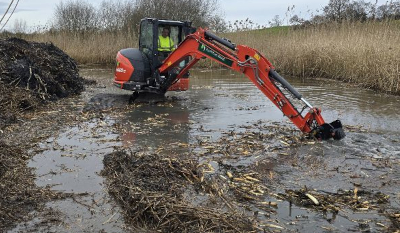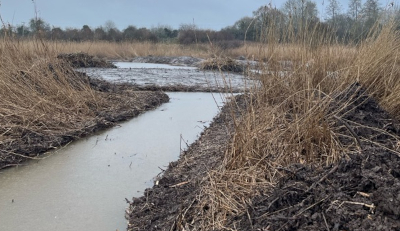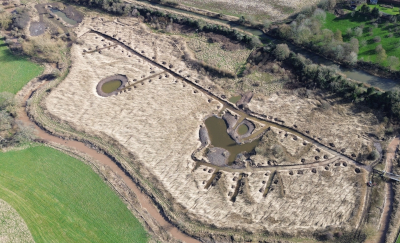WYCHAVON DISTRICT COUNNCIL and the Canal & River Trust elected to restore the reed bed and enhance the biodiversity at Coney Meadow in early 2025.
It enlisted the expertise of marine engineering specialists, The Rothen Group. With only five weeks to complete the project ahead of nesting season in February, the team were able to quickly work throughout January and create multiple new habitats to boost the local ecology.
 Become overgrown
Become overgrown
Since the installation of the reed bed at Coney Meadow wetlands, the site had started to become overgrown following a lack of maintenance. Given the area’s existing biodiversity for regional wildlife such as swallows and skylarks, Wychavon District Council, alongside the Canal & River Trust, decided to restore the wetlands, and at the same time use the discarded reeds from the maintenance works as part of a larger scheme to enhance the local ecology.
With the upcoming nesting season fast approaching, they needed a contractor who could complete the project while understanding the importance of the biodiversity work being carried out.
Thanks to its prior experience working on similar projects and its in-house ecologist who could advise on the best ways to attract new species to the area, The Rothen Group was appointed as the chosen contractor to complete the work.
 Boosting regional ecology
Boosting regional ecology
To enhance the biodiversity in Coney Meadow, The Rothen Group was tasked with completing a variety of improvements to the site. The team started with the removal of the overgrown reeds, reducing them so that the existing plants would have more space to grow without impacting the underwater oxygen levels whilst allowing more light into the water-body to increase diversity of plants.
Following this, the existing overspill structure connecting the wetlands to the local canal was deliberately blocked using silt. By doing so, the existing water table in the reed bed would increase, providing more space for underwater plants and creatures to thrive.
This was not the only change. To encourage even more biodiversity, six new ponds were dug by The Rothen Group’s team. Not only did each new addition vary in size and depth, but they were created with shelves. These flat ledges underneath the water at different depths created different microhabitats to allow different species to thrive. This includes male newts who prefer cooler, deeper water to ‘display to their females’ and their female counterparts who live near plants closer to the surface to lay their eggs.
A network of scrapes was also dug by The Rothen Group’s team so that aquatic animals and plants could grow. Scrapes are shallow depressions in the ground that fill with water throughout the year. These 2.5m depressions would serve as a feeding ground for the local bird population and other species who feed on these creatures, encouraging them to the site for local bird watchers. Alongside this, the scrapes would serve as a water management system, helping prevent the meadow from flooding during storms and heavy rainfall.
Finally, above water, The Rothen Group’s team set out to create a range of hibernacula so that hibernating animals could have a safe space during the winter months. These were created using the waste generated throughout the project, including the reeds, soil and five trees that were cut down. Offering a thick layer of insulation, the hibernacula would attract species such as hedgehogs and grass snakes to the region for the next winter season.
 The ecology benefits
The ecology benefits
Following the completion of the project, Coney Meadow offered a wide range of new habitats to grow the biodiversity in the region, encouraging new species to both breed and live. Speaking on the project, Charlotte Rothen, Director and ecologist at The Rothen Group explained:
“When Wychavon District Council and the Canal & River Trust contacted us regarding this project, we knew that biodiversity sat at the heart of it.
“With a tight deadline to complete the work ahead of the upcoming nesting season, our team worked incredibly hard to action the Council and Trust’s plans and create the new spaces for animals and plants to thrive. Our team was able to utilise every shred of waste generated throughout the project and repurpose it so nothing had to be transported away and disposed of – a significant benefit for all.
“While we will have to wait until next year to see the true impact of the project, I believe it is safe to say that the next regional survey will showcase a significant rise in the biodiversity present at Coney Meadow.”
Shaun Pope, ecologist at Canal & River Trust, related:
"Coney Meadow provides a valuable array of habitats for a large number of important species. The habitat improvements carried out will contribute to safeguarding the location as an important wildlife site.
"The proximity of Coney Meadow to Droitwich Barge Canal provides an overlap between the habitats offered by the canal corridor and the ponds, scrapes and reedbeds of the site along with the nearby River Salwarpe. Such interconnected natural areas allow wildlife to move freely between habitats, helping to conserve populations for the future.”
Cllr Beverley Hardman, Executive Board Member for Environment at Wychavon District Council added:
“Across the country, local authorities are taking proactive steps to increase the ecology in their region so that native plants and species aren’t impacted due to housing developments and other infrastructure projects.
“The Rothen Group’s team were able to take our vision and implement it so that hundreds of new insects, birds, arachnids and amphibians have a safe space to flourish. It will be great to see how the project impacts local population levels in the coming years.”
